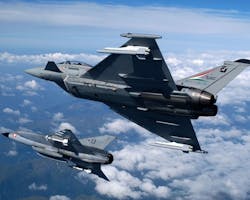EADS Group focuses on aerospace strengths, synergies, reorganization
LONDON, 12 Sept. 2013. The EADS Group, a global provider of aerospace, defense, and related services, is just embarking upon a landmark reorganization expected to take roughly one year to complete.
Officials at the European Aeronautic Defence and Space Company N.V. (EADS) in Toulouse, France, last month announced two significant changes: Airbus Military, Astrium, and Cassidian will be integrated into one defense and space division, and the company will be renamed to the Airbus Group.
The EADS Group currently employs roughly 145,000 people over 170 sites worldwide, describes Cassidian’s Lothar Belz, head of technology/trade press at DSEI 2013 in London.
At DSEI, EADS is focused on a variety of aerospace and defense innovations, including distributed flight training systems and cybersecurity solutions.
Engineers and executives throughout EADS are anticipating technologies needed three to five years ahead, Belz describes. “Aircraft is a major focus. Airborne combat is a major concern, manned and unmanned. A lot of question marks remain around integrating unmanned aircraft in public airspace,” adds Belz of Cassidian in the EADS Group, which boasts more than a decade of experience in unmanned aerial systems (UAS), from compact tactical unmanned aerial vehicles (UAVs) to large medium-altitude long-endurance (MALE) and high-altitude long-endurance (HALE) systems.
EADS executives and engineers at DSEI were also focused on meeting the manned aircraft needs of global militaries. “International forces are much more active” in air combat, affirms Max Baldwin in charge of Cassidian Strategy in the EADS Group, which is focused on meeting evolving air requirements of militaries around the globe. One such focus is on effective, high-fidelity flight training systems, such as the company’s Typhoon training solution on display at DSEI 2013 in London.
The Eurofighter Typhoon twin-engine, canard-delta wing, multirole fighter designed and manufactured by EADS, Alenia Aeronautica, and BAE Systems is “the most popular military aircraft outside the U.S.,” Belz explains. The company’s Typhoon training solution melds the aerospace and technology strengths throughout the EADS organization, including geospatial data and terrain databases from Astrium, as well as training and simulation, cockpit avionics, and security technologies.
Cost-effective synthetic flight training will increase, Baldwin predicts, as will distributed training across different areas of a single nation or across multiple countries.
